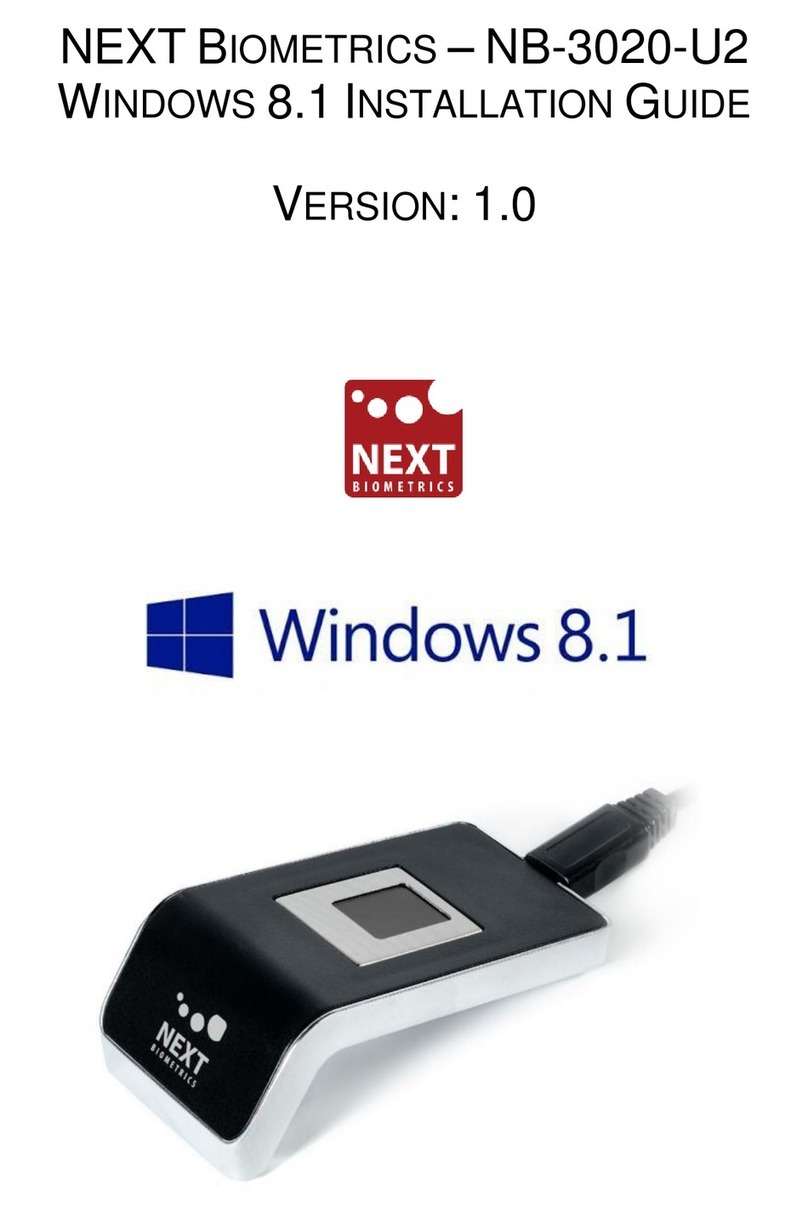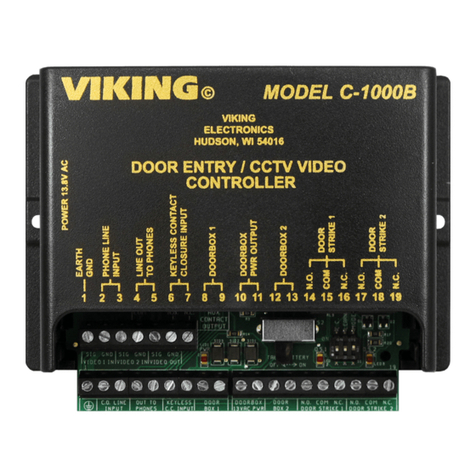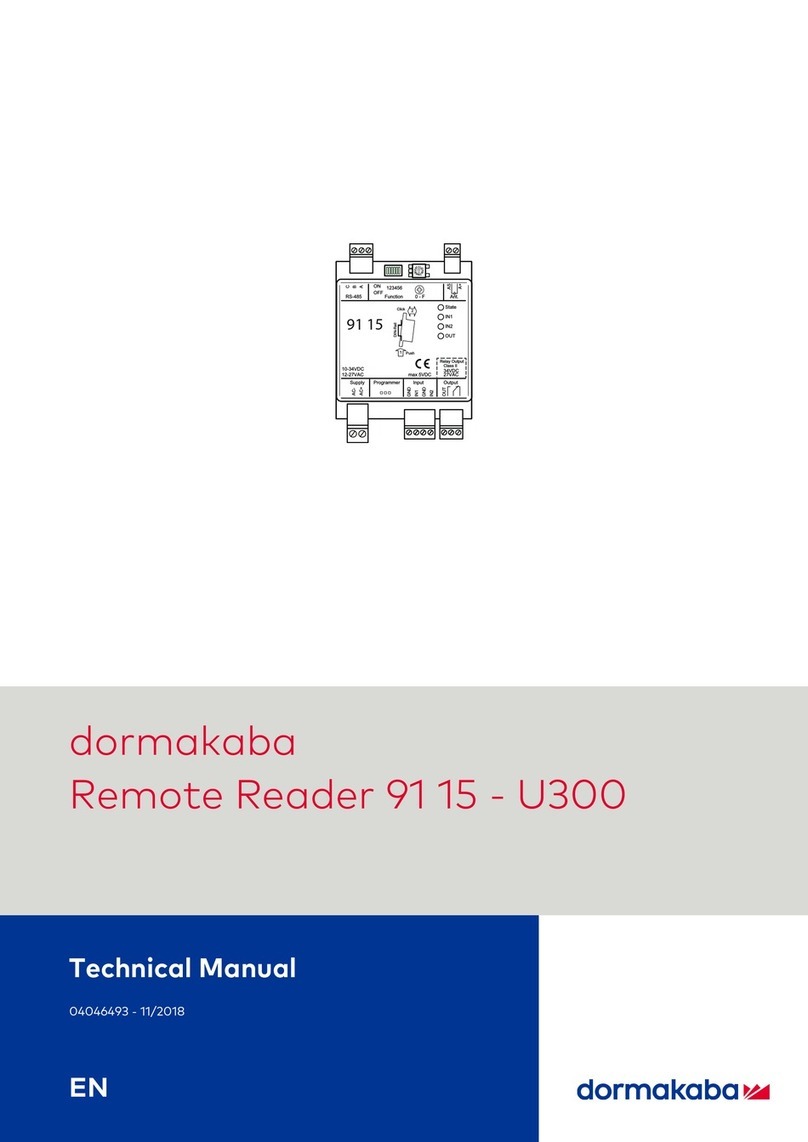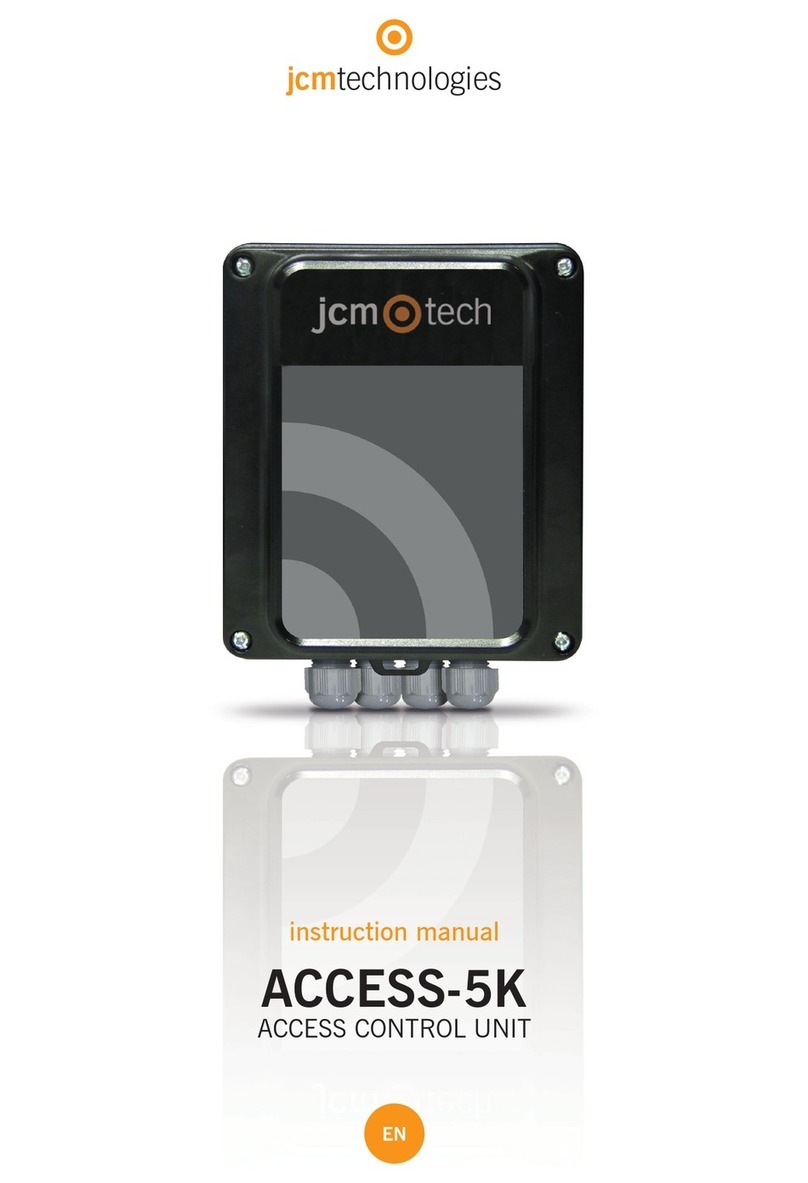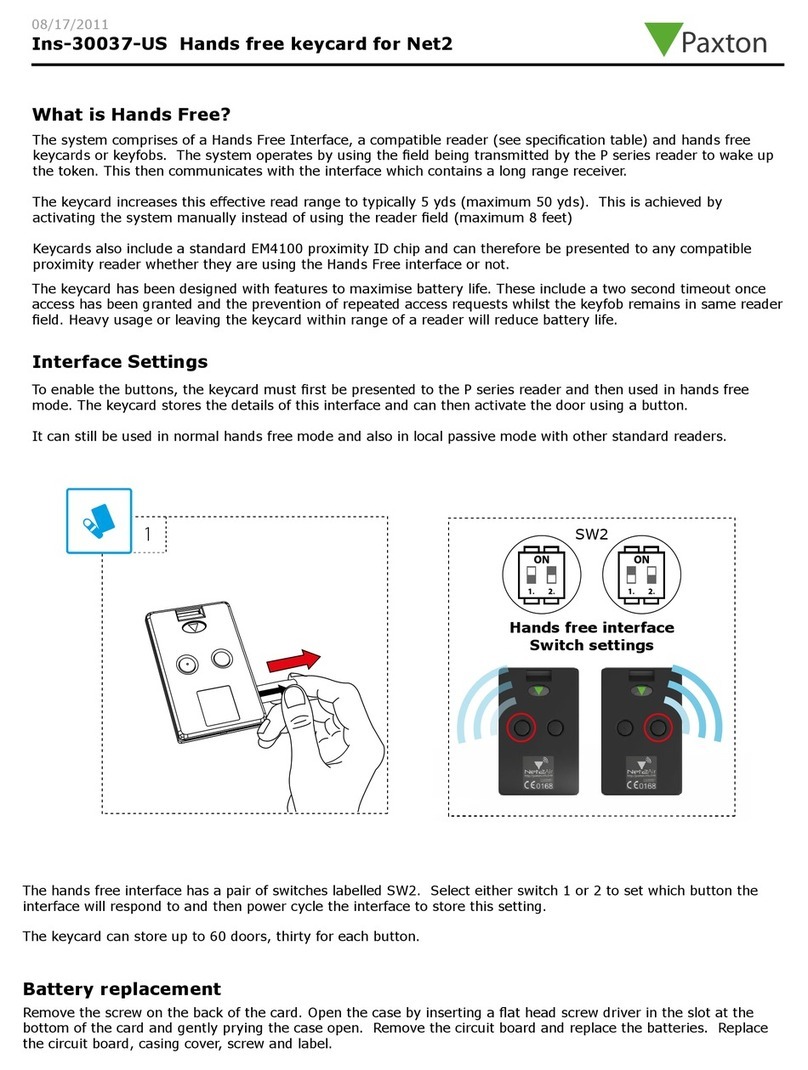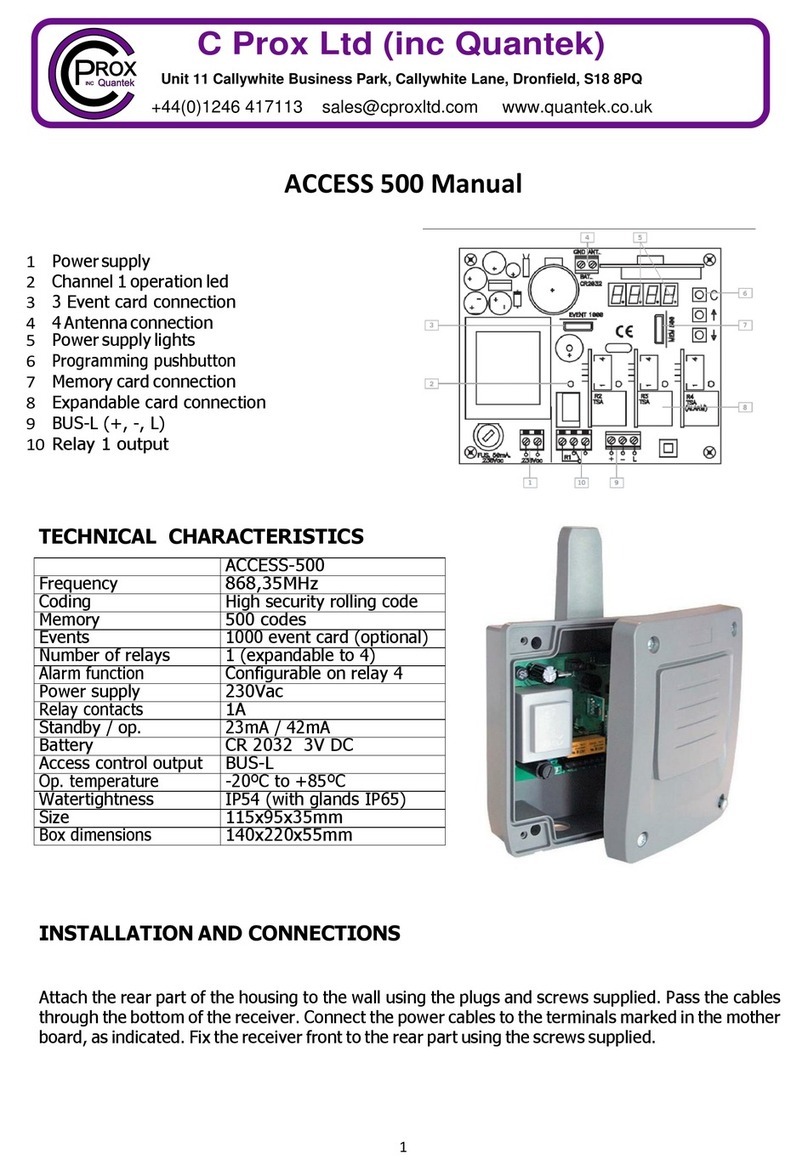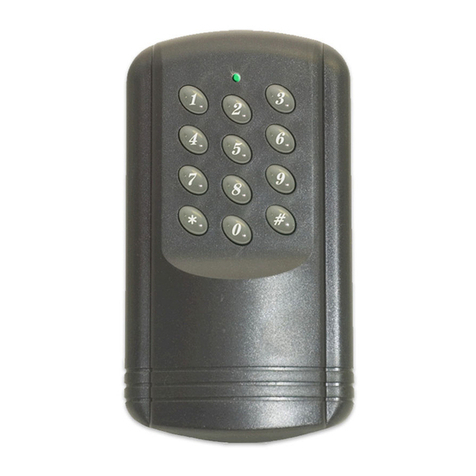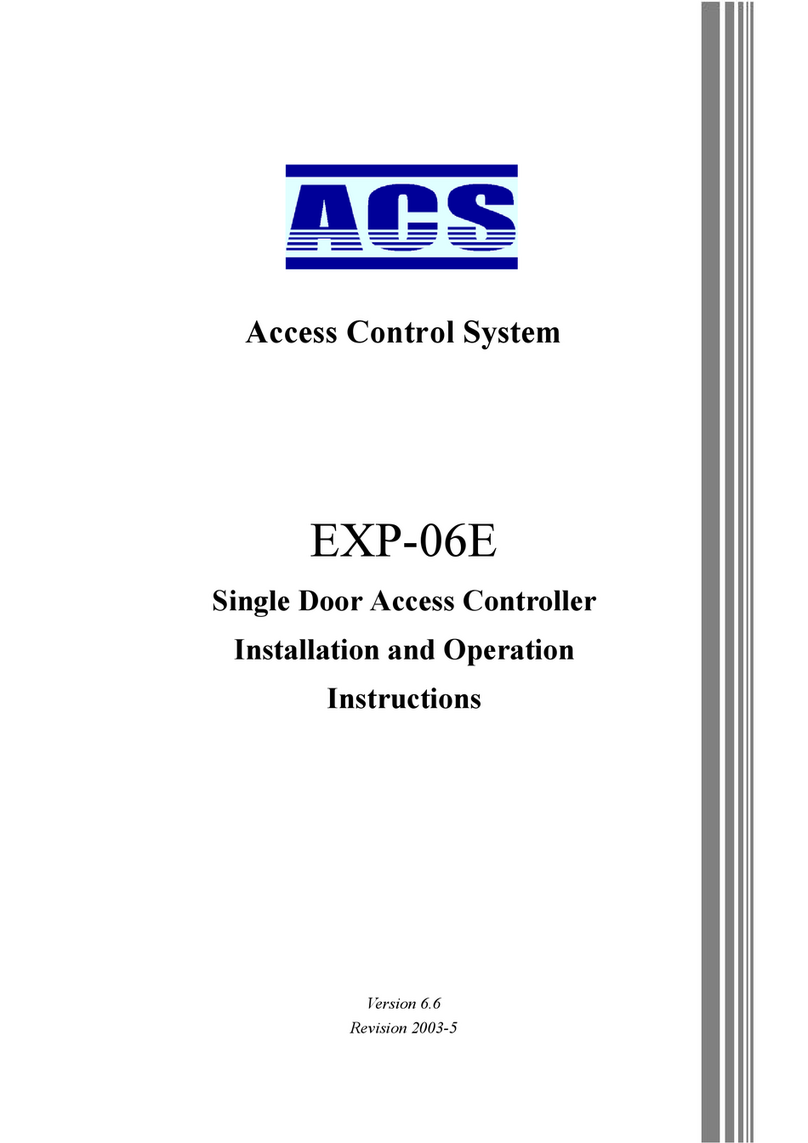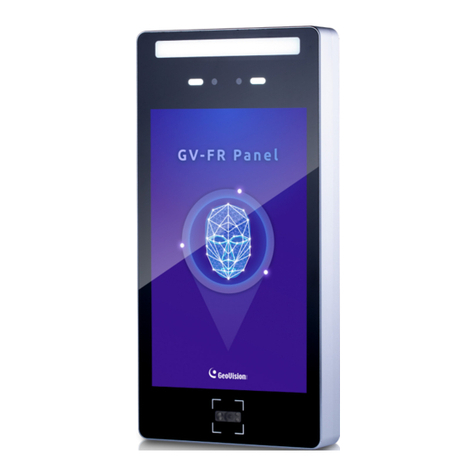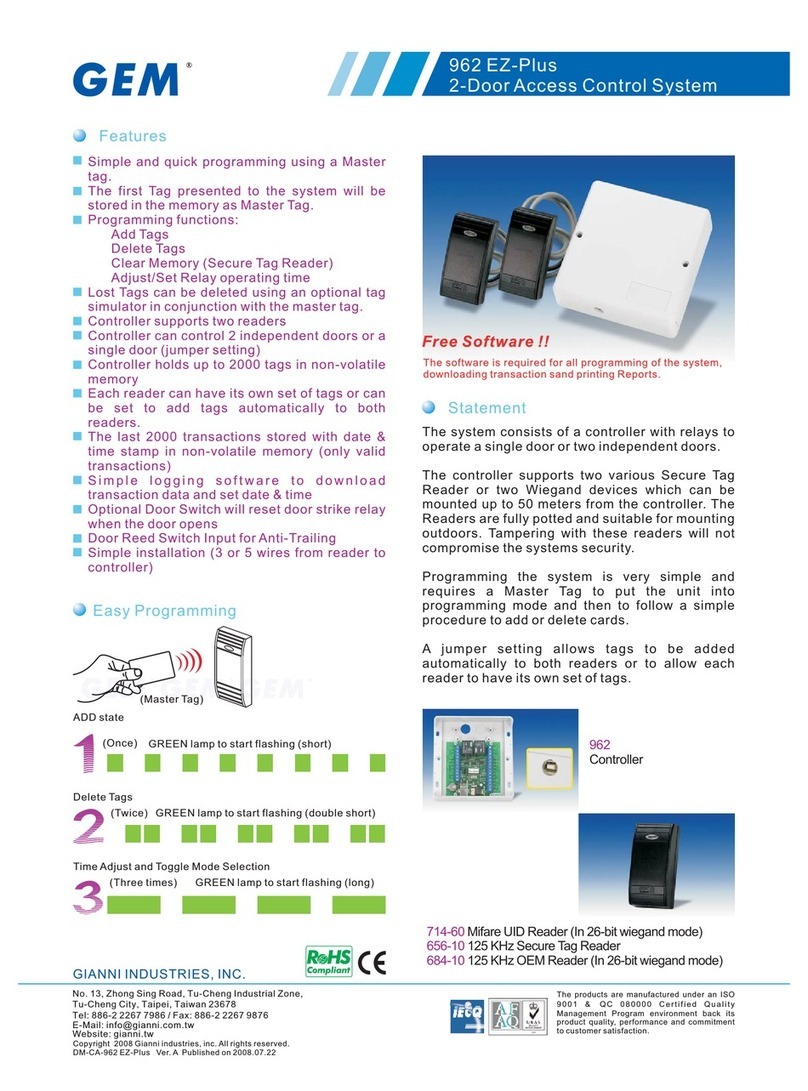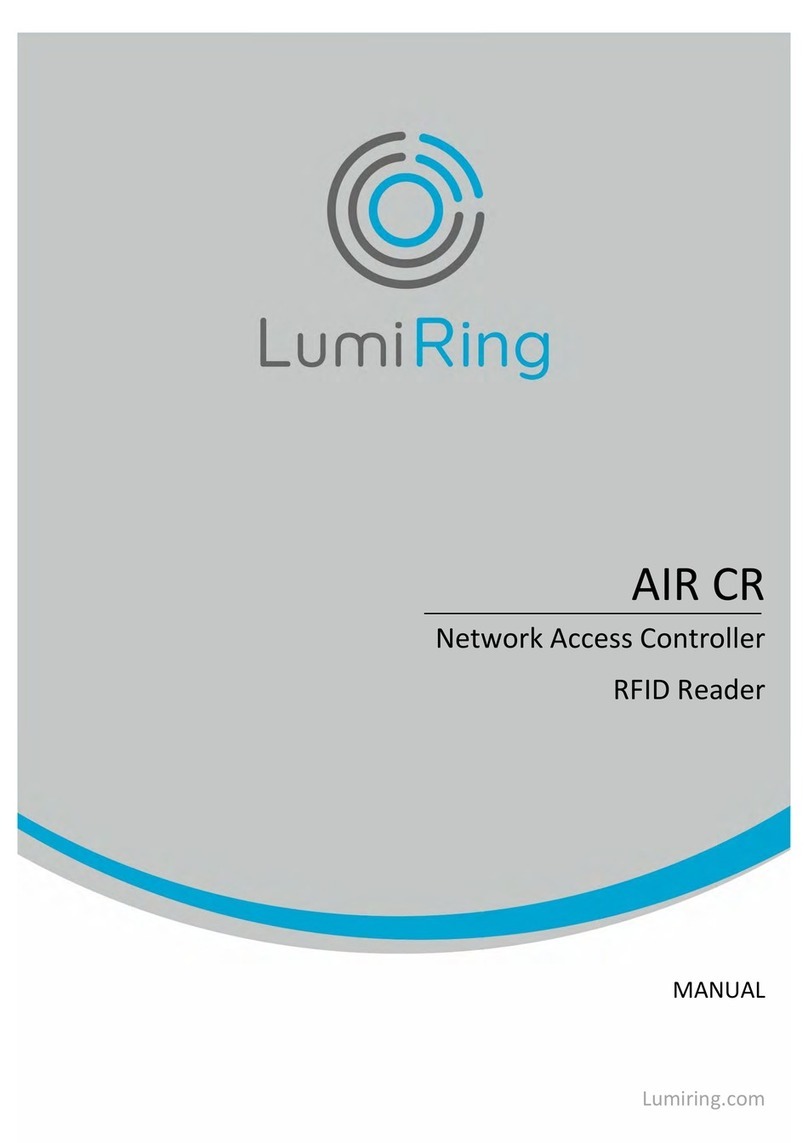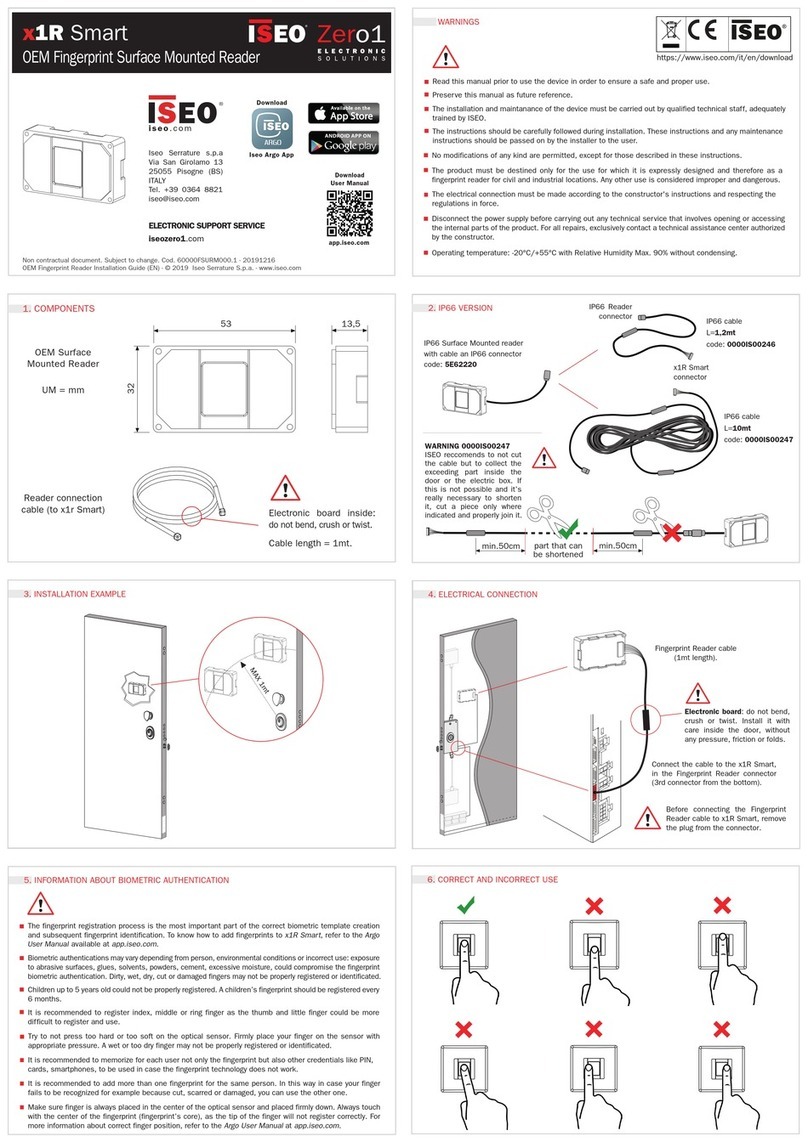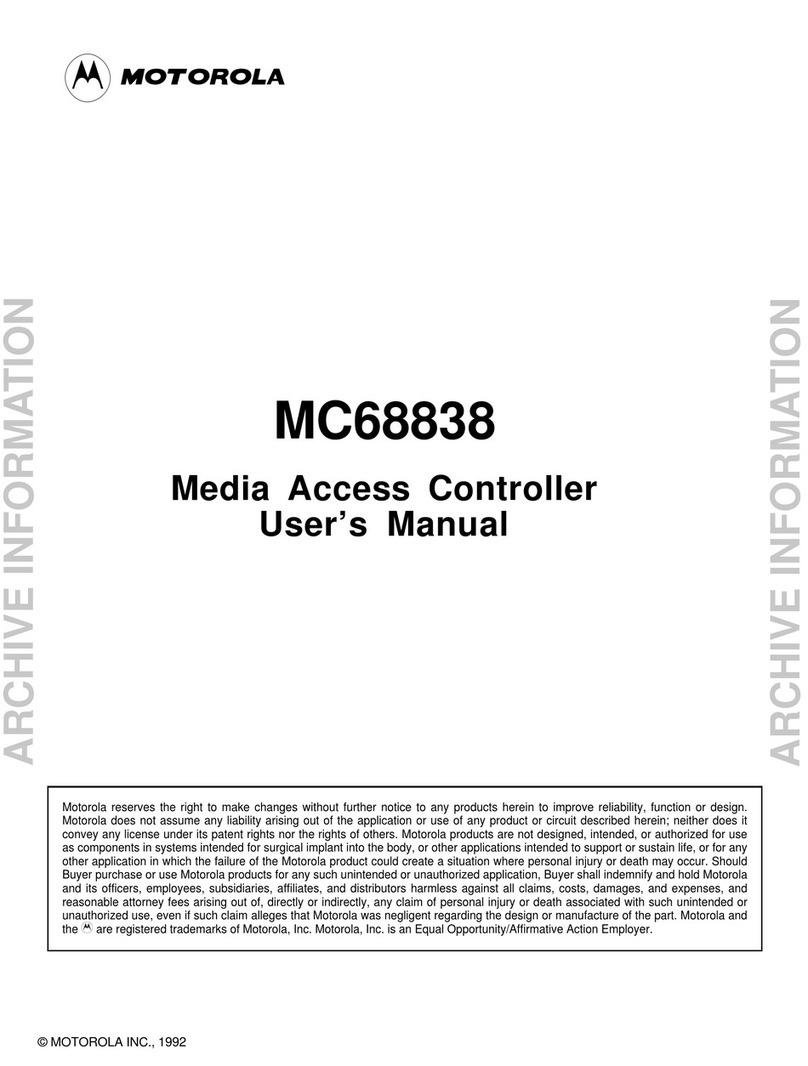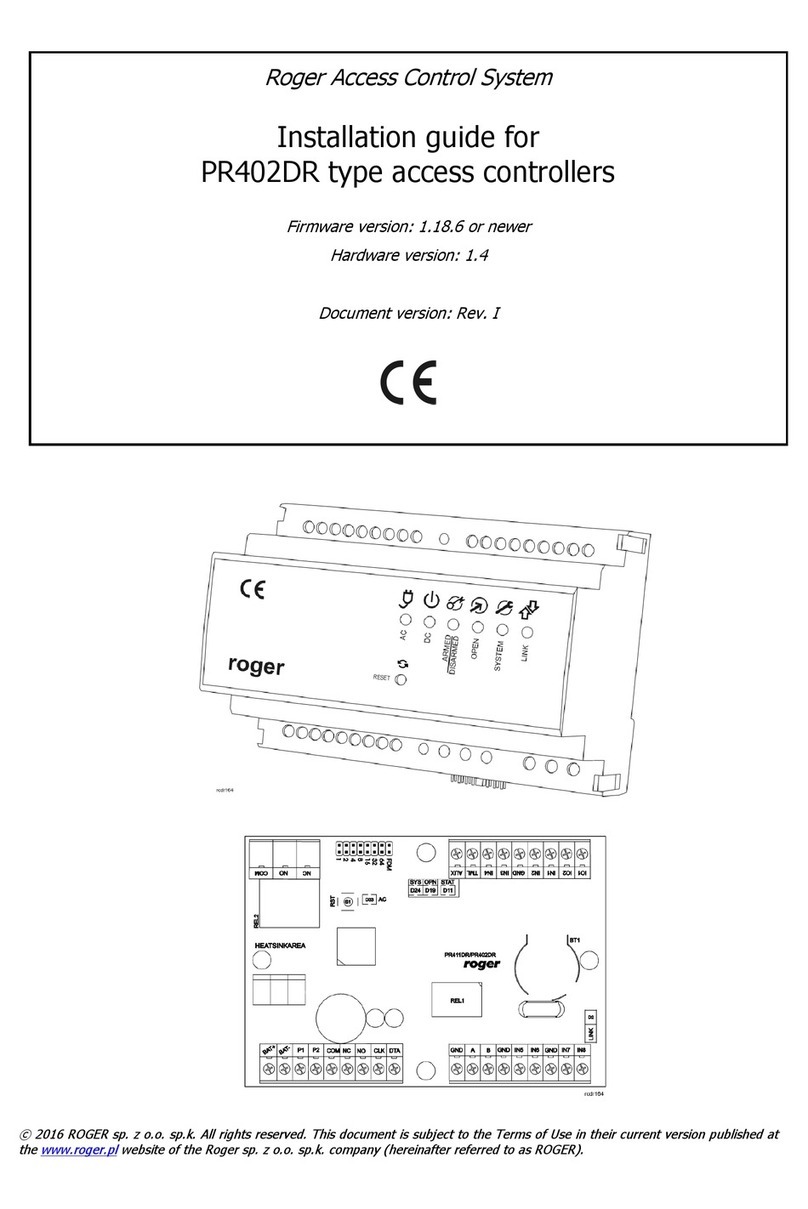Rittal CMC III VX User manual

Assembly and operating instructions
CMCIIItransponder reader VX
DK7030.232
DK7030.233

2 Rittal CMC III transponder reader VX
Foreword
EN Foreword
Dear Customer,
Thank you for choosing our CMC III transponder reader
VX (referred to hereafter as "transponder reader")!
We wish you every success.
Yours,
Rittal GmbH & Co. KG
Rittal GmbH & Co. KG
Auf dem Stuetzelberg
35745 Herborn
Germany
Tel.: +49(0)2772 505-0
Fax: +49(0)2772 505-2319
E-mail: [email protected]
www.rittal.com
www.rittal.de
We are always happy to answer any technical
questions regarding our entire range of products.

Rittal CMC III transponder reader VX 3
Contents
EN
Contents
1 Notes on documentation......................4
1.1 CE labelling ...................................................... 4
1.2 Storing the documents..................................... 4
1.3 Symbols used in these operating instructions ... 4
1.4 Associated documents..................................... 4
2 Safety instructions................................5
2.1 General safety instructions................................ 5
2.2 Service and technical sta................................ 5
3 Product description..............................6
3.1 Functional description and components ........... 6
3.1.1 Function ........................................................... 6
3.1.2 Components .................................................... 6
3.2 Proper use, foreseeable misuse........................ 6
3.3 Scope of supply ............................................... 6
4 Transport and handling.........................7
4.1 Transport.......................................................... 7
4.2 Unpacking........................................................ 7
5 Installation............................................ 8
5.1 Safety instructions............................................ 8
5.2 Siting location requirements.............................. 8
5.3 Installation procedure ....................................... 8
5.3.1 Installation note ................................................ 8
5.3.2 Installation on a VX and VX IT sheet steel door . 8
5.3.3 Installation on a VX glazed door........................ 8
5.3.4 Installation on a VX IT glazed door or VX IT
vented door...................................................... 9
5.4 Connecting the transponder reader .................. 9
6 Operation...........................................10
6.1 Activating the transponder reader................... 10
6.2 Operating and display elements...................... 10
6.3 LED displays .................................................. 10
6.4 Operating the CMCIII Processing Unit from
the website..................................................... 10
6.4.1 Configuration tab............................................ 10
6.4.2 Monitoring tab ................................................ 11
6.5 Manual changes to the "access.cmc3" file...... 11
6.5.1 Downloading the file ....................................... 11
6.5.2 Editing the file................................................. 11
6.5.3 Uploading the file............................................ 12
7 Storage and disposal .........................13
7.1 Storage .......................................................... 13
7.2 Disposal ......................................................... 13
8 Technical specifications......................14
9 Customer service addresses..............15

4 Rittal CMC III transponder reader VX
1 Notes on documentation
EN 1 Notes on documentation
1.1 CE labelling
Rittal GmbH & Co. KG hereby confirms that the CMC
III transponder reader VX is compliant with the EC EMC
Directive 2014/30/EC. An appropriate declaration of
conformity has been prepared. It can be provided on
request.
1.2 Storing the documents
The assembly and operating instructions as well as
all applicable documents are an integral part of the
product. They must be passed to those persons who
are engaged with the unit and must always be avail-
able and on hand for the operating and maintenance
personnel.
1.3 Symbols used in these operating in-
structions
The following symbols are used in this documentation:
Danger!
Hazardous situation leading directly to
death or serious injury if the instruc-
tions are not followed.
Warning!
Hazardous situation which may lead
directly to death or serious injury if the
instructions are not followed.
Caution!
Hazardous situation which may lead to
(minor) injuries if the instructions are
not followed.
Note:
Identification of situations that can lead to
material damage.
◾ This symbol indicates an "action point" and shows
that you should perform an operation or procedure.
1.4 Associated documents
– Installation and Short User Guide
– Assembly and operating instructions for compatible
base systems, e.g. CMC III Processing Unit
Note:
Additional compatible base systems can be
found on the internet at www.rittal.com for
model no. DK 7030.233. The term "base
systems" is used in these instructions as
placeholder for the various systems.
– CMC III Access Control/Door Control Module (DCM)
assembly and operating instructions

Rittal CMC III transponder reader VX 5
2 Safety instructions
EN
2 Safety instructions
2.1 General safety instructions
Please observe the subsequent general safety instruc-
tions for the installation and operation of the system:
– Use only original Rittal products or products recom-
mended by Rittal in conjunction with the transponder
reader.
– Please do not make any changes to the transponder
reader that are not described in this manual or in the
associated manuals.
– The operational safety of the transponder reader
is only warranted in case of use as intended and
according to the rules. The technical specifications
and limit values stated must not be exceeded under
any circumstances. In particular, this applies to the
specified ambient temperature range and IP degree
of protection.
– The transponder reader may only be opened for
mounting purposes. The unit does not contain any
parts that need servicing.
– Operating the system in direct contact with water,
aggressive materials or inflammable gases and va-
pours is prohibited.
– Other than these general safety instructions, ensure
you also observe the specific safety instructions
when the tasks described in the following chapters
are performed.
2.2 Service and technical sta
– The mounting, installation, commissioning, mainte-
nance and repair of this unit may only be performed
by qualified mechanical and electro-technical trained
personnel.
– Only properly instructed personnel may work on a
unit while in operation.

6 Rittal CMC III transponder reader VX
3 Product description
EN 3 Product description
3.1 Functional description and components
3.1.1 Function
The transponder reader serves to release enclosure or
room doors through a contactless process whereby a
transponder card is held in front of it. The unique card
number is checked in the connected CMC III Process-
ing Unit (base systems) and the corresponding door
release is initiated where applicable. The transponder
reader has an identification that allows it to be detected
automatically by the CMC III Access Control/DCM.
Note:
In the following text, the designation
"CMCIII Processing Unit" refers to the
"CMC III Processing Unit" variants and also
to the base systems. All text passages that
apply only to a specific variant are identified
accordingly.
3.1.2 Components
The CMC III transponder reader consists of a compact
plastic housing in RAL9005 or RAL 7035. The reader
unit is seated in black at the front. It is indicated with a
symbol ("Hand" and "Card").
3.2 Proper use, foreseeable misuse
The CMC III transponder reader VX serves exclusively
to release doors using transponder cards. It may be
used only together with the CMC III Processing Unit,
CMC III Access Control or Door Control Module (DCM).
Any other use is not permitted.
The unit is state of the art and built according to rec-
ognised safety regulations. Nevertheless, incorrect use
may result in damage to or faults with the system and
other material assets.
Consequently, the unit must only be used properly
and in a technically sound condition! Any malfunctions
which impair safety should be rectified immediately!
Follow the operating instructions!
The intended use also includes the observance of the
documentation provided and fulfilling the inspection
and maintenance conditions.
Rittal GmbH & Co. KG is not liable for any damage
which may result from failure to comply with the docu-
mentation provided. The same applies to the non-ob-
servance of the valid documentation for any deployed
accessories and the base systems.
Inappropriate use may result in danger. Inappropriate
use includes:
– Use of impermissible tools.
– Improper operation.
– Improper rectification of malfunctions.
– Use of accessories not approved by Rittal GmbH &
Co. KG.
3.3 Scope of supply
– CMCIIItransponder reader VX
– Accessories provided (Fig.1)
– Installation Guide and Short User Guide
1x
2x K40x40 2x
2x
K40x30
K40x12
1x
1x
4x
Fig.1: Accessories provided

Rittal CMC III transponder reader VX 7
4 Transport and handling
EN
4 Transport and handling
4.1 Transport
The unit is delivered in a carton.
4.2 Unpacking
◾ Remove the unit's packaging materials.
Note:
After unpacking, the packaging materials
must be disposed of in an environmentally
friendly way. They consist of the following
materials:
Polyethylene film (PE film), cardboard.
◾ Check the unit for any damage that may have oc-
curred during transport.
Note:
Damage and other faults, e.g. incomplete
delivery, should be reported immediately,
in writing, to the shipping company and to
Rittal.
◾ Remove the unit from the PE film.

8 Rittal CMC III transponder reader VX
5 Installation
EN 5 Installation
5.1 Safety instructions
◾ Please observe the valid regulations for installation
in the country in which the transponder reader is in-
stalled and operated, and the national regulations for
accident prevention. Please also observe any internal
company regulations, such as work, operating and
safety regulations.
◾ The technical specifications and limit values stated
must not be exceeded under any circumstances. In
particular, this applies to the specified ambient tem-
perature range and IP degree of protection.
◾ If a higher IP protection class is required for a special
application, the transponder reader must be installed
in an appropriate housing or in an appropriate enclo-
sure with the required IP degree of protection.
5.2 Siting location requirements
To ensure the unit functions correctly, the conditions
for the installation site of the unit specified in section8
"Technical specifications" must be observed.
Electromagnetic interference
– Interfering electrical installations (high frequency)
should be avoided.
5.3 Installation procedure
There are generally several options for installing the
transponder reader:
– Installation on a VX and VX IT sheet steel door
– Installation on a VX glazed door
– Installation on a VX IT glazed door or VX IT vented
door
5.3.1 Installation note
◾ Cover the area around where holes are to be drilled
before drilling in order to prevent damage and
scratches.
5.3.2 Installation on a VX and VX IT sheet steel
door
The installation is performed directly on the frame of a
VX and VX IT sheet steel door.
◾ Drill suitably sized holes at the required part of the
frame of the VX sheet steel door (Fig.2).
◾ Use a 90° countersink to deburr the holes for cable
entry.
◾ Attach the transponder reader to the prepared loca-
tion using the pan-head screws provided.
40
KB 40x12
MA= 2,5 Nm
Ø4,5
Ø8
166
23
Fig.2: VX and VX IT sheet steel door installation
5.3.3 Installation on a VX glazed door
The installation is performed directly on the frame of a
VX glazed door.
◾ Drill suitably sized holes at the required part of the
frame of the VX glazed door (Fig.3).
◾ Use a 90° countersink to deburr the holes for cable
entry.
◾ Clean away any splinters at the point where the tran-
sponder reader is to be attached.
◾ Attach the transponder reader to the prepared loca-
tion using the flat-headed screws provided.

Rittal CMC III transponder reader VX 9
5 Installation
EN
55
44
KB 40x40
MA= 2,5 Nm
Ø4,5
Ø8
166
Fig.3: VX glazed door installation
5.3.4 Installation on a VX IT glazed door or VX IT
vented door
The installation on the frame of a VX IT glazed door
or VX IT vented door is performed with the provided
compensating panel.
◾ First dismantle the locking bars.
◾ Drill suitably sized holes at the required part of the
frame of the VX IT glazed door (Fig.4).
◾ Use a 90° countersink to deburr the holes for cable
entry.
◾ Clean away any splinters at the point where the tran-
sponder reader is to be attached.
◾ Attach the compensating panel incl. transponder
reader to the prepared location using the flat-headed
screws provided.
◾ Finally, reattach the locking bars.
13
37,5
KB 40x30
MA= 2,5 Nm
Ø4,5
Ø8
166
23
Ø9,4x90°
Ø4,5
Option
Fig.4: VX IT glazed door, VX IT vented door installation
5.4 Connecting the transponder reader
Note:
The transponder reader is compatible with
the CMC III Access Control (DK 7030.202)
and the Door Control Module (DCM,
DK7030.501).
The Access Control/DCM supplies the transponder
reader with the necessary operating voltage via the
connection cable. A separate power supply unit does
not need to be connected.
◾ First disconnect the CAN bus from the Access Con-
trol/DCM.
◾ Fit the associated handle to the door to be moni-
tored.
◾ Connect this handle via the connection cable to the
Access Control/DCM.
◾ Connect the transponder reader via the connection
cable to the Access Control/DCM.
◾ Connect the CAN bus to the Access Control/DCM
again.

10 Rittal CMC III transponder reader VX
6 Operation
EN 6 Operation
6.1 Activating the transponder reader
After connecting the transponder reader to an Access
Control/DCM using the connection cable, the tran-
sponder reader starts automatically (see section5.4
"Connecting the transponder reader"). Separate activa-
tion is not required.
6.2 Operating and display elements
31
2
Fig.5: Front of the transponder reader
Legend
1 "ERROR" LED (white)
2 Transponder reader
3 "ACCESS" LED (white)
6.3 LED displays
Two LEDs for the status display are integrated into
the front of the transponder reader (Fig.5, item 1 and
item3).
Designation Status
ACCESS If the connection is correct, continuously
flashes every 5-10 seconds.
If an authorised transponder card is
applied, the LED lights up continuously
for approx. 2 seconds.
ERROR If an unauthorised transponder card is
applied, both LEDs (ACCESS and ER-
ROR) flash together every 5-10 seconds.
Tab. 1: LED flashing codes
6.4 Operating the CMCIII Processing Unit
from the website
After logging on to the CMC III Processing Unit, the
web interface for operating the device is displayed.
6.4.1 Configuration tab
Access authorisation settings can be made in the "Se-
curity" group frame in the Configuration tab.
◾ First select the "Processing Unit" node in the naviga-
tion area.
◾ Select the Configuration tab in the configuration
area.
To add a new transponder card:
◾ Hold the transponder card in front of the transponder
reader before selecting the "Access Configurations"
dialogue.
Regardless of the next work steps:
◾ In the Security group frame, click on the Access
Configuration button.
The "Access Configurations" dialogue opens.
To configure a transponder card:
◾ Select the line with the required entry to change the
configurations stored for this.
◾ Click the Edit button.
The "Access Configuration" dialogue opens.
Parameter Explanation
Type Configuration of an access. The "Card"
entry must be selected here.
Code Transponder card code.
User Selection of the user authorised for the
access. The user must have been created
in advance.
Information Specific additional information for the ac-
cess. This text is also added for the user
in the CMCIIIProcessing Unit logfile.
Tab. 2: "Access Configuration" dialogue
All connected access modules are displayed in tabular
form.
Parameter Explanation
Use Enable or disable individual access mod-
ules.
Device
Name
Specific description of the Access Con-
trol/DCM or (virtual) access controller to
which the access module to be switched
is connected.
Serial Num-
ber
Serial number of the Access Control/DCM
or (virtual) access controller to which the
access module to be switched is con-
nected.
Tab. 3: "Devices" table
Note:
A user must be assigned to the transponder
card. Otherwise, access isn't possible even
with the appropriate transponder card.
To delete an access authorisation via transponder
card:
◾ Select the line with the required entry you wish to
delete.

Rittal CMC III transponder reader VX 11
6 Operation
EN
◾ If necessary, select another entry by keeping the shift
key pressed. All lines from the first entry selected to
the last entry selected (inclusive) are selected.
◾ If necessary, select further entries by keeping the
"Ctrl" key pressed. These lines are added individually
to the selection.
◾ Click the Delete button.
All selected access authorisations are immediately
deleted without a confirmation prompt.
6.4.2 Monitoring tab
The description of the transponder reader is added and
the current status of the transponder reader can be
viewed in the Monitoring tab.
Note:
As the transponder reader does not have a
separate entry in the left tree structure, all
information on this point can be found in
the CMC III Access Control/DCM operating
instructions.
6.5 Manual changes to the "access.cmc3"
file
Alternatively, the access authorisation settings can also
be made directly in the "access.cmc3" file. This file is
created automatically in the "upload" directory of the
CMC III Processing Unit when it is started for the first
time. Alternatively, they can be created by holding a
transponder card in front of the transponder reader.
Note:
If the "access.cmc3" file is removed from
the folder, access is only then possible
using the three predefined access codes
"1001", "1002" and "1003". All other access
authorisations have to initially be added
again to a newly created file.
6.5.1 Downloading the file
Note:
The following descriptions assume that you
establish an (S)FTP connection using the
"FileZilla" program. If another program is
used, the file may have to be downloaded
and uploaded in a dierent way.
◾ First establish an FTP or SFTP connection to the
CMCIII Processing Unit from a PC (see the assembly
and operating instructions for the CMCIII Processing
Unit).
◾ In the left-hand subwindow (PC), switch to the folder
where you wish to locally save the "access.cmc3"
file.
◾ Switch to the "upload" folder in the right-hand sub-
window (CMCIII PU).
◾ Right-click the "access.cmc3" file and select the
"Download" action.
◾ Disconnect the (S)FTP connection between the PC
and CMCIII PU.
If there is no "access.cmc3" file in the "upload" directo-
ry, this has to be created first.
◾ Hold any transponder card in front of the reader unit.
The file is now generated in the "upload" folder.
◾ Establish an (S)FTP connection between the PC and
CMCIII PU again and download the file.
◾ Disconnect the (S)FTP connection between the PC
and CMCIII PU again.
6.5.2 Editing the file
The file can now be edited using a text editor. Rittal
recommends using "Notepad++" for this instead of the
standard "Notepad" editor installed under Windows.
This is available online as freeware.
Fig.6: "access.cmc3" file in Notepad++
The file is structured as follows:
– Lines starting with a "#" are comment lines. These
contain basic information on the CMCIII Processing
Unit.
– Lines with "Crd" as first entry contain the authorised
card numbers of the transponder cards.
– The line with "4-Eyes" as first entry contains the time
interval for the registration in the four-eyes principle.
– Lines with "Keypad" as first entry contain the assign-
ment of reader units to individual access modules.
Transponder cards
The individual lines contain the following entries:
Parameter Explanation
Crd Card number of a transponder card for
authorised access.
User
User to be entered in the CMC III Pro-
cessing Unit logfile on opening with the
associated transponder card. This user
has to exist in the CMCIII PU.
Information
Specific additional information for the ac-
cess. This text is also added for the user
in the CMCIIIProcessing Unit logfile.

12 Rittal CMC III transponder reader VX
6 Operation
EN Parameter Explanation
Handle
Serial number of the Access Control/DCM
or (virtual) access controller to which the
access module to be switched is connect-
ed. Several comma-delimited entries for
dierent Access Control/DCM can also be
added here.
Tab. 4: Entries for transponder cards
Note:
In addition, the file can contain lines that
begin with the "Key" parameter. Such lines
contain information about the number
codes that are used with a numeric code
reader.
The entries are explained in detail using the following
example configuration.
Fig.7: Example configuration
– Handle 1 is opened using access code "1234" (line
11 in the editor window). User "cmc" and the infor-
mation "Info 1" are entered in the CMCIII PU logfile.
– Handle 2 is opened using access code "123456"
(line 12). User "Rittal" and the information "Info 2" are
entered in the CMCIII PU logfile.
– Both handles are opened using access code
"12345678" (line 13). User "admin" and the informa-
tion "Info 3" are entered in the CMCIII PU logfile.
In lines 15 to 17, a transponder card has also been as-
signed to each of the users. These transponder cards
open the same handles as the access codes above.
The respective users and associated information are
entered in the CMCIII PU logfile.
Time interval for the four-eyes principle
The time interval for registration in the four-eyes princi-
ple is specified in the line with the "4-Eyes" entry.
Parameter Explanation
4-Eyes Time interval in seconds within which the
two persons must register with their tran-
sponder cards or their number code.
Tab. 5: Time interval for the four-eyes principle
Assignment of reader units to access modules
The lines for the assignment of reader units to access
codes contain the following entries:
Parameter Explanation
Keypad Serial number of the Access Control or
the (virtual) access controller to which the
reader unit is connected with the following
assigned handles or doors.
Handle Serial number of the Access Control/DCM
or (virtual) access controller to which the
access module to be switched is connect-
ed. Several comma-delimited entries for
dierent Access Control/DCM can also be
added here.
Tab. 6: Assignment of reader units to access modules
Note:
If no access module is assigned to the
"Handle" entry, the reader unit will be as-
signed to all access modules. In this case,
all doors activated for the transponder card
or the number code will be opened, irre-
spective of which reader unit is used.
6.5.3 Uploading the file
Once all entries have been made in the "access.cmc3"
file, this file has to be stored in the "upload" directory
on the CMCIII Processing Unit again.
◾ Establish an FTP or SFTP connection to the CMCIII
Processing Unit from a PC again.
◾ Switch to the "upload" folder in the right-hand sub-
window (CMCIII PU).
◾ In the left-hand subwindow (PC), switch to the folder
where you have stored the revised version of the
"access.cmc3" file.
◾ Right-click the "access.cmc3" file and select the
"Upload" action.
◾ If the file cannot be uploaded this way, first delete the
existing "access.cmc3" file from the "upload" directo-
ry and then upload the file from the PC again.
◾ Finally, disconnect the (S)FTP connection between
the PC and CMCIII PU.
The access authorisations have now been updated.

Rittal CMC III transponder reader VX 13
7 Storage and disposal
EN
7 Storage and disposal
7.1 Storage
If the device is not used for a long period, Rittal recom-
mends that it be disconnected from the mains power
supply and protected from damp and dust.
7.2 Disposal
Since the transponder reader consists mainly of the
"housing" and "circuit board" parts, the device must be
passed on to the electronic waste recycling system for
disposal.

14 Rittal CMC III transponder reader VX
8 Technical specifications
EN 8 Technical specifications
Technical specifications CMC III transponder reader VX
Model no. DK7030.232/DK7030.233
W x H x D (mm) 50 x 190 x 25
Operating temperature range 0°C…+55°C
Storage temperature -45°C…+85°C
Operating humidity range 5%…95% relative humidity, non-condensing
Protection category IP40 to IEC60529
Technology Transponder 13.56MHz
The following tags can
be read ISO 14443A
Mifare, Legic Advant, HID, FeliCa, (Legic Prime on request).
Detailed information can be found in the internet at
www.rittal.de for model no. DK 7030.232 or DK 7030.233.
Frequency 13.56MHz
Connection cable (m) 2.9
Inputs and outputs Interface for Access Control/DCM 1 x
Operation/signals LED display 2 x white
Tab. 7: Technical specifications

Rittal CMC III transponder reader VX 15
9 Customer service addresses
EN
9 Customer service addresses
For technical queries, please contact:
Tel.: +49(0)2772 505-9052
E-mail: [email protected]
Homepage: www.rittal.com
For complaints or service requests, please contact:
Tel.: +49(0)2772 505-1855
E-mail: [email protected]

◾ Enclosures
◾ Power Distribution
◾ Climate Control
◾ IT Infrastructure
◾ Software & Services
RITTAL GmbH & Co. KG
Auf dem Stuetzelberg · 35745 Herborn · Germany
Phone +49 2772 505-0
www.rittal.com/contact
You can find the contact details of all
Rittal companies throughout the world here.
10.2019/D-0000-00002250-00-EN
Other manuals for CMC III VX
1
This manual suits for next models
2
Table of contents
